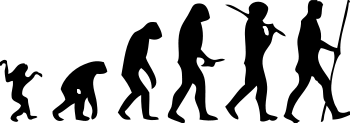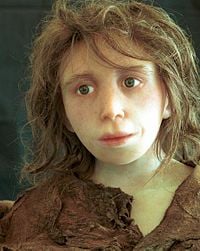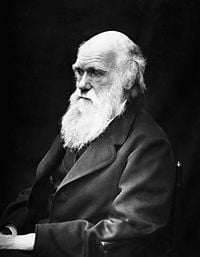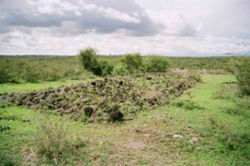Paleoanthropology
Paleoanthropology, a sub-discipline of Anthropology and paleontology. Studying hominid fossil evidence, such as petrified bones and footprints, and even incorporating knowledge of current primate species, paleoanthropologist essentially study the origin of human beings as a biological spices.
Etymology
The word paleoanthropology is an academic creation that combines the Ancient Greek paleo, which refers to prehistoric time periods, with "anthropology," itself a combination of Greek words which mean "study of man".[1]
Paleoanthropology is actually a sub-division of two different larger fields of study: Anthropology and Paleontology, and is sometimes known as human paleontology. Anthropology is concerned with the study of humankind's cultural and biological evolution through all time. Paleontology is the study of prehistoric life forms on Earth through the examination of fossils. Hence paleoanthropology studies the prehistoric ancestors of mankind, referred to in a group as hominids. The discipline often overlaps with geology (the study of rocks and rock formations) as well as with botany, biology, zoology and ecology – fields concerned with life forms and how they interact.
Origins
The modern field of paleoanthropology (study of human origins) began in the nineteenth century with the discovery of "Neanderthal man" (the eponymous skeleton was found in 1856, but there had been finds elsewhere since 1830). However, fossils of Neanderthal's were widely misinterpreted as skeletons of modern humans with deformation or disease[2].
Research activities
Paleoanthropologist are usually operating in one of two arenas; searching for physical remains and evidence in the field, or analyzing finds in a laboratory. In the field, discovering physical remains and other fossils follows similarly painstaking procedures that archaeologists use when uncovering cultural remains. Areas where evidence is thought to be buried is systematically noted for geological data before layers of earth are removed slowly. Noting the condition and details of the location of the find is just as crucial as uncovering fossils. Africa and Asia are two of the most popular sites for paleoanthropologist in the field for they have historically yielded the oldest and most promising evidence. However, as recent finds in South America and Europe push the date of mankind's origin further back, paleoanthropologist can be found worldwide in attempts to make a discovery.
Once remains are discovered, they are usually sent to a laboratory or research center where they are carefully studied, using chemical and physical dating methods, X-Rays, MRIs, and other special tools. Paleoanthropologist are most interested in noting how the finds are similar and how they are different from already established ancestral lines.
Theories and findings
The science of paleoanthropology is based upon the scientific principle of Human evolution, which deals with both the pattern of evolution (descent with modification, the non-causal relations between ancestral and descendant species) and the process of evolution (various theories involving mechanisms and causes for the pattern observed, including fundamental concepts such as natural selection, punctuated equilibrium, and design, and specific scenarios, such as those involving movement from trees, use of tools, "out of Africa," etc).
The idea that humans are similar to certain great apes had been obvious to people for some time, but the idea of the biological evolution of species in general was not significantly advanced until after Charles Darwin published On the Origin of Species in 1859. Though Darwin's first book on evolution did not address the specific question of human evolution—"light will be thrown on the origin of man and his history" was all Darwin wrote on the subject—the implications of evolutionary theory were clear to contemporary readers. Debates between Thomas Huxley and Richard Owen focused on the idea of human evolution. Huxley convincingly illustrated many of the similarities and differences between humans and apes in his 1863 book Evidence as to Man's Place in Nature. By the time Darwin published his own book on the subject, Descent of Man, it was already a well-known interpretation of his theory—and the interpretation helped make the theory of natural selection highly controversial. Even many of Darwin's original supporters (such as Alfred Russel Wallace and Charles Lyell) balked at the idea that human beings could have evolved their apparently boundless mental capacities and moral sensibilities through natural selection.
Since the time of Carolus Linnaeus, the great apes were considered the closest relatives of human beings, based on morphological similarity. In the nineteenth century, it was speculated that their closest living relatives were chimpanzees and gorillas, and based on the natural range of these creatures, it was surmised humans share a common ancestor with other African apes and that fossils of these ancestors would ultimately be found in Africa.
It was not until the 1920s that hominid fossils were discovered in Africa. In 1924, Raymond Dart described Australopithecus africanus. The type specimen was the Taung Child, an australopithecine infant discovered in a cave deposit being mined for concrete at Taung, South Africa. The remains were a remarkably well-preserved tiny skull and an endocranial cast of the individual's brain. Although the brain was small (410 cm3), its shape was rounded, unlike that of chimpanzees and gorillas, and more like a modern human brain. Also, the specimen exhibited short canine teeth, and the position of the foramen magnum (the hole in the skull where the spine enters) was evidence of bipedal locomotion. All of these traits convinced Dart that the Taung baby was a bipedal human ancestor, a transitional form between apes and humans.[3] Another 20 years would pass before Dart's claims were taken seriously, following the discovery of more fossils that resembled his find. The prevailing view of the time was that a large brain evolved before bipedality. It was thought that intelligence on par with modern humans was a prerequisite to bipedalism.
The australopithecines, which now are widely seen as direct ancestors leading to the human lineage, have been classified as either gracile (Australopithecus genus) or robust (Paranthropus genus). However, some consider the robust species aethiopicus, boisei, and robustus as included within the genus Australopithecus. In the 1930s, when the robust specimens were first described, the Paranthropus genus was used. During the 1960s, the robust variety was moved into Australopithecus. The recent trend has been back to the original classification as a separate genus.
Substantial evidence has been marshaled for the fact that humans have descended from common ancestors by a process of branching (descent with modification) and for a primate origin of humans. However, proposals for the specific ancestral-descendant relationships and for the process leading to humans tend to be speculative. And, while the theory of natural selection typically is central to scientific explanations for the process, evidence for natural selection being the directive or creative force is limited to extrapolation from the microevolutionary level (changes within the level of species).
Human evolution/Species chart
Debates
While there are many aspects of human evolution that paleoanthropologist agree upon, there are several puzzles in regards to the human evolutionary line that modern scholars must address, and as such, causes debates within the discipline. One of the most contested issues is where humans originated from. There are two dominant general views on the issue of human origins, the Out of Africa position and the multiregional position.
The Out of Africa, or Out of Africa II, or replacement model holds that after there was a migration of Homo erectus (or Homo ergaster) out of Africa and into Europe and Asia, these populations did not subsequently contribute significant amounts of genetic material (or, some say, contributed absolutely nothing) to later populations along the lineage to Homo sapiens.[4] Later, approximately 200,000 years ago, there was a second migration of hominids out of Africa, and this was modern H. sapiens that replaced the populations that then occupied Europe and Asia[5]. This view maintains a specific speciation event that led to H. sapiens in Africa, and this is the modern human.
The multiregional or continuity camp hold that since the origin of H. erectus, there have been populations of hominids living in the Old World and that these all contributed to successive generations in their regions[6]. According to this view, hominids in China and Indonesia are the most direct ancestors of modern East Asians, those in Africa are the most direct ancestors of modern Africans, and the European populations either gave rise to modern Europeans or contributed significant genetic material to them, while their origins were in Africa or West Asia[7]. There is genetic flow to allow for the maintenance of one species, but not enough to prevent racial differentiation.
There are various combinations of these ideas. Overall, the disagreement between these two camps has caused "fairly severe strife within the paleoanthropologist community"[8]. Multiregionalism is often "portrayed as a racist theory," while Out of Africa II "has often been portrayed as a religiously motivated idea" that strives to align with the biblical story of Genesis[9].
Other issues facing paleoanthropology deal with how current evidence is used to create theories. A major contention among some is that the fossil record remains fragmentary. No fossils of hominids have been found for the period between 6 and 13 million years ago (mya), the time when branching between the chimpanzee and human lineages is expected to have taken place[10]. Furthermore, as author Ernst Mayr notes "most hominid fossils are extremely incomplete. They may consist of part of a mandible, or the upper part of a skull without face and teeth, or only part of the extremities."[11]. Even the famous "Lucy" finding (Australopithecus afarensis) was only a 40 percent complete female skeleton and lacked a head (Gould 1994).
Coupled with this is a recurrent problem that interpretation of fossil evidence is heavily influenced by personal beliefs and prejudices. Fossil evidence often allows a variety of interpretations, since the individual specimens may be reconstructed in a variety of ways[12]. As Mayr notes, "subjectivity is inevitable in the reconstruction of the missing parts," and virtually all hominid finds and interpretations are "somewhat controversial!"[13]. Another author, recounts several examples where the pieces of fossils found offered a variety of reconstructions that were sometimes dramatically different, such as long face versus a short face, a heavy brow, a missing forehead. Different interpretations of two sections of a fossil skull and how to place one of those pieces led Roger Lewin to recount, "How you held it really depended on your preconceptions. It was very interesting what people did with it"[14].
Renowned paleoanthropologist
- Robert Ardrey (1908-1980), whose African Genesis (1961), The Territorial Imperative (1966), The Social Contract (1970), and The Hunting Hypothesis (1976) detail the mid-20th century transition in paleoanthropologist studies and methodology.
- Davidson Black (1884-1934), discovered Sinanthropus pekinensis (now Homo erectus pekinensis) or the “Peking Man.” Despite the fact that Africa was later found to be the origin of humankind, proving Black's theory of an Asian origination wrong, Black's work greatly advanced our knowledge of the development of human beings in Asia.[15]
- Carleton S. Coon (1904-1981), in such works as The Origin of Races (1962), The Story of Man (1954), and "The Races of Europe" (1939) concluded that sometimes different racial types had annihilated other types while in other cases warfare and / or settlement had only led to the partial displacement of racial types.
- Eugene Dubois (1858-1940), discovered several fossils of seemingly hominid origin, and called his finds Pithecanthropus erectus or Java man—"a species in between humans and apes." Later, they were classified as Homo erectus. What Dubois found in 1890s was a set of teeth, a skullcap, and a left femur (thigh bone). The femur suggested that its owner had walked erect. From the teeth and the skull, Dubois argued that the specimen was exactly between humans and apes on the evolutionary timeline.[16]
- Johann Carl Fuhlrott (1803-1877), famous for the discovery of the Neanderthal 1, a Neanderthal specimen found during an archaeology dig in August 1856.
- Louis Leakey (1903-1972), one of the most renowned paleoanthropologist of all time. Among Leakey’s many extraordinary finds was the 1959 unearthing of Zinjanthropus, a robust hominid that hinted at the great complexity of mankind's evolutionary roots. Leakey called it Zinjanthropus boisei, and believed that it belonged in the line of direct human ancestors. Later, however, it was classified as australopithecus. In 1964 he and his wife discovered the skull and hand of what was recognized as a new species—Homo habilis, or “the human who used tools.” Using the carbon-14 dating technique, researchers from the University of California at Berkeley have estimated that the site where they were found, and the bones themselves, were 1.75 million years old.[17]
- Mary Leakey (1913-1996), as famous as her husband (Louis), Mary discovered a set of footprints discovered at the Laetoli site (Site G), located 27 miles (45 kilometers) south of Olduvai Gorge. The site is Pliocene, dated by the Potassium-argon method to 3.7 million years ago. A line of hominid footprints, was discovered in 1976-1977 by Leakey, Richard Hay, and their team, preserved in powdery ash from an eruption of the 20 kilometers distant Sadiman volcano. Soft rain cemented the ash-layer (15 centimeters thick) to tufa, without destroying the prints. In time, they were covered by other ash deposits. The footprints demonstrate that these hominids walked upright habitually, as there are no knuckle-impressions. The feet do not have the mobile big toe of apes; instead, they have an arch (the bending of the sole of the foot) typical of modern humans. The discovery caused serious debate among scientists, requiring them to change their theories concerning the evolution of bipedalism.[18]
- Richard Leakey (1944- ), son of Mary and Louis Leaky. Building upon the legacy of his parents, Richard Leakey continued to work toward the understanding of human evolution. In 1969, his discovery of a cranium of Australopithecus boisei caused great excitement. A Homo habilis skull (ER 1470) and a Homo erectus skull (ER 3733), discovered in 1972 and 1975, respectively, were among the most significant finds of Leakey's early expeditions. In 1978, an intact cranium of Homo erectus (KNM-ER 3883) was discovered. In 1984 he made his most important discovery—"Turkana Boy," discovered by Kamoya Kimeu, a member of Leakey’s' team, was the nearly complete skeleton of a 12-year-old (or possibly 9-year-old) Homo erectus who died 1.6 million years ago. It was one of the first well-preserved skeletons of that origin ever found.[19]
- André Leroi-Gourhan (1911-1986), created theories about human evolution involving the notion that the transition to bipedality freed the hands for grasping, and the face for gesturing and speaking, and thus that the development of the cortex, of technology, and of language all follow from the adoption of an upright stance. Whatcharacterizess humanity in its distinction from animals is thus the fact that tools and technology are a third kind of memory (in addition to the genetic memory contained in DNA and the individual memory of the nervous system), and thus a new form of anticipation, or programming
- Kenneth Oakley (1911-1981), known for his work in the relative dating of fossils by fluorine content, which was instrumental in the exposure in the 1950s of the Piltdown Man hoax.[20]
Notes
- ↑ Paleoanthropology]. (n.d.). Dictionary.com Unabridged (v 1.1). Retrieved May 05, 2008, from Dictionary.com website.
- ↑ Gould, S. J. 1990. Men of the Thirty-third Division. Natural History April, 1990: 12,14,16-18, 20, 22-24.
- ↑ Wheelhouse, Frances. 2001.Dart: Scientist and man of grit. Hornsby, Australia: Transpareon Press. ISBN 0908021216
- ↑ Kreger, C. D. 2005. "Homo sapiens: Introduction". Archaeology.info. Retrieved June 2, 2008.
- ↑ Kreger, C. D. 2005. "Homo sapiens: Introduction". Archaeology.info. Retrieved June 2, 2008.
- ↑ Kreger, C. D. 2005. "Homo sapiens: Introduction". Archaeology.info. Retrieved June 2, 2008.
- ↑ Kreger, C. D. 2005. "Homo sapiens: Introduction". Archaeology.info. Retrieved June 2, 2008.
- ↑ Kreger, C. D. 2005. "Homo sapiens: Introduction". Archaeology.info. Retrieved June 2, 2008.
- ↑ Kreger, C. D. 2005. "Homo sapiens: Introduction". Archaeology.info. Retrieved June 2, 2008.
- ↑ Mayr, Ernst. 2001. What Evolution Is. New York: Basic Books. ISBN 0465044255
- ↑ Mayr, Ernst 2001. What Evolution Is. New York: Basic Books. ISBN 0465044255
- ↑ Wells, Jonathan. 2000. Icons of Evolution. Washington, DC: Regnery Publishing. ISBN 0895262762
- ↑ Mayr, Ernst. 2001. What Evolution Is. New York: Basic Books. ISBN 0465044255
- ↑ Wells, Jonathan. 2000. Icons of Evolution. Washington, DC: Regnery Publishing. ISBN 0895262762
- ↑ "Black, Davidson." Encyclopædia Britannica. 2008. Encyclopædia Britannica Online. 2 June 2008 <http://www.britannica.com/eb/article-9015460>.
- ↑ Shipman, Pat. 2001. The man who found the missing link: The extraordinary life of Eugene Dubois. Diane Publishing Co. ISBN 075679160X
- ↑ Cole, Sonia. Leakey's Luck: The Life of Louis Seymour Bazett Leakey, 1903-1972. Harcourt. 1975. ISBN 0151494568
- ↑ Bowman-Kruhm, Mary. 2005. The Leakeys: A Biography. Westport, CT: Greenwood Press. ISBN 0313329850
- ↑ Bowman-Kruhm, Mary. 2005. The Leakeys: A Biography. Westport, CT: Greenwood Press. ISBN 0313329850
- ↑ Oakley, Kenneth. (2008). In Encyclopædia Britannica. Retrieved June 2, 2008, from Encyclopædia Britannica Online: http://www.britannica.com/eb/article-9056605
External links
All links retrieved October 28, 2007.
- Paleoanthropology in the 1990's - by James Q. Jacobs
- Fossil Hominids - talkorigins.org
- Aspects of Paleoanthropology - ucla.edu
- Paleoanthropology, Evolution and Human Origins - Becoming Human
Credits
New World Encyclopedia writers and editors rewrote and completed the Wikipedia article in accordance with New World Encyclopedia standards. This article abides by terms of the Creative Commons CC-by-sa 3.0 License (CC-by-sa), which may be used and disseminated with proper attribution. Credit is due under the terms of this license that can reference both the New World Encyclopedia contributors and the selfless volunteer contributors of the Wikimedia Foundation. To cite this article click here for a list of acceptable citing formats.The history of earlier contributions by wikipedians is accessible to researchers here:
The history of this article since it was imported to New World Encyclopedia:
Note: Some restrictions may apply to use of individual images which are separately licensed.



